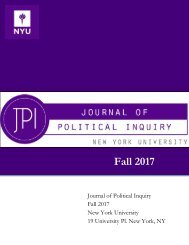JPI Spring 2018
You also want an ePaper? Increase the reach of your titles
YUMPU automatically turns print PDFs into web optimized ePapers that Google loves.
How to Understand the Sino-U.S. Rapprochement:<br />
A Study on the American Perceptions of China from 1949-1972<br />
Kaibo Wang<br />
INTRODUCTION<br />
U.S. President Richard Nixon’s pivotal visit to the People’s Republic of China (PRC) in 1972<br />
came as a surprise to much of the world. After 25 years of tension, the American president—who<br />
represented the liberal world–visited Beijing, which was controlled by the Chinese Communist Party.<br />
Furthermore, the Shanghai Communiqué, which showed the willingness of the U.S. to coordinate<br />
with a communist country in opposition to the Soviet Union, was announced during Nixon’s visit.<br />
Nixon called his trip “the week that changed the world.” 1 Why would the leader of the liberal Western<br />
Bloc visit China, a frightening and communist authoritarian regime? Nixon’s diplomacy is only a<br />
surprise if one conceptualizes China simply as a dangerous communist enemy. However, I argue that<br />
the Sino-U.S. rapprochement is not so unexpected when one considers how American perceptions of<br />
China changed between 1949 and 1972. Assessing the relationship between China and the United<br />
States in a more complete cultural and historical context provides a better picture of the Sino-U.S.<br />
rapprochement.<br />
It is important to grasp the role that perceptions played during the Cold War. During this<br />
period in the U.S., the PRC was usually characterized purely as a communist enemy. This<br />
oversimplification ignores the history of Sino-U.S. cooperation that led Americans to feel that China<br />
was “lost” after 1949. It also overlooks shifts in American ideology after the Sino-Soviet split. These<br />
two issues of perception paved the way for the Sino-U.S. rapprochement. Thus, the image of China<br />
as simply a communist adversary from 1949 to 1972 is misleading because it exaggerates the negative<br />
attitudes of the American public that were informed by the threat of the Cold War and perpetuated<br />
by misinformation and fear.<br />
The reality of the Sino-U.S. relationship is indeed more complex. The feeling among American<br />
policymakers that China was “lost” after the PRC took control in 1949 indicates that America’s former<br />
strategic plan actually required and aspired to good relations with China. The Truman government<br />
believed that China could be a valuable counterweight to the Soviet Union. 2 Additionally, when<br />
communist China publicly separated itself from the U.S.S.R. in the 1960s, the U.S. experienced an<br />
ideological shift where perceptions of China as a Cold War enemy gradually faded. This nostalgia for<br />
the former Sino-U.S. friendship and changing American beliefs about China were prerequisites for the<br />
rapprochement that occurred in 1972 and cannot be forgotten when considering American attitudes<br />
toward China.<br />
The essay is divided into four sections. The first section discusses American perceptions of<br />
China during the Cold War. The second section re-examines the long history between the two<br />
countries and the “loss of China” as a way to comprehend the eventual Sino-U.S. rapprochement. The<br />
third section analyzes several shifts in the American perspective on Communist China: the negative<br />
images of Communist China were strengthened after both the Chinese Civil war and the Korean War<br />
1<br />
“The Week That Changed the World”: The 40th Anniversary of President Nixon's China Trip, Wilson Center, Last modified May 15, 2017.<br />
https://www.wilsoncenter.org/article/the-week-changed-the-world-the-40th-anniversary-president-nixons-china-trip#sthash.fYCFtu4U.dpuf.<br />
2<br />
Akira Iriye, Across the Pacific: An Inner History of American-East Asian Relations (Chicago: Imprint Publications, 1992), 254.<br />
<strong>JPI</strong> Fall 2017, pg. 48
















